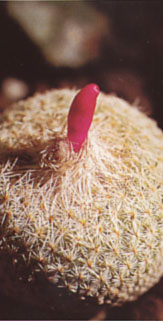
|
|
| Epithelantha micromeris - Hikuli Mulato - Cactaceae - Southwestern North America, Mexico |
|
E. micromeris is credited with great intellectual and moral qualities. This "medicine" is said to give speed to runners, prolong life, and make the eyes large and clear to be able to see sorcerers. Both it, and its fruit, are ingested as a stimulant and protector by traditional Tarahumara foot-runners, but are considered less effective than L. williamsii or A. fissuratus. Its fruits are laid before the altar in ceremonies, and it had continued to play a minor part in Tarahumara festivals well into the 20th century. Similar to terms surrounding A. fissuratus, any words describing the effects of E. micromeris must be viewed as only abbreviated renderings of traditional reports, and should not be interpreted according to a western understanding. E. micromeris is valued by the Tarahumara as "hÝkuli mulato," the "dark skinned peyote." Just why it is considered "dark skinned" is not fully fathomed since the plant has very small white spines almost completely hiding a green epidermis. It is likely the name has a much more symbolic rather than literal meaning. In 1902 Lumholtz stated that "hÝkuli rosapara" was "a more advanced vegetative stage" of E. micromeris, but he also stated that hÝkuli mulato and hÝkuli rosapara looked "quite different" than each other. In 1899 Rose first proposed, as gathered from earlier publications by Lumholtz, that hÝkuli rosapara was in fact Mamillopsis senilis due to its description by Lumholtz as being "white and spiny" and due to other reports describing the reverence the Indians held for M. senilis (see M. senilis). E. micromeris is one of two accepted species in the genus while a number of variations exist which are often cited as species. In addition to numerous alkaloids, five triterpenes and one sterol have been reported within E. micromeris. Its fruit are known as "chilitos." Contains the following alkaloids Tyramine N-Methyltyramine Hordenine 3-Methoxytyramine 3,4-Dimethoxyphenethylamine N-Methyl-3,4-dimethoxyphenethylamine Epithelanthic acid Methylepithelanthate Methylmachaerinate Oleanolic acid ▀-Sitosterol Methyl oleanate
|
|
| Related
Articles : |
|
| Email
This Article To A Friend - Print
This Article Articles can be E-mailed to a friend and you can get a printable version of the article IMPORTANT: We provide all information for educational purposes only, and endorse or recommend nothing here. A special thanks to Keith for all his support and insight. |
|
